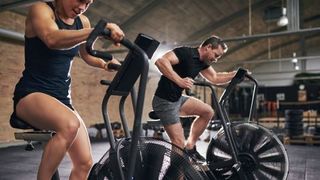What Is The RPE Scale?
Using the RPE scale can help you train smarter and get fitter

We don’t have to tell you that what’s easy for you might be difficult for someone else, and vice versa, but consider two parkrunners who run 5K in 20 minutes. For one, it’s a lung-burning PB, for the other an easy recovery run. You can measure the distance and the time, but what about the exertion? That can be compared using the rating of perceived exertion (RPE) scale – probably to the annoyance of the exhausted runner, but they won’t have the energy to protest.
For more information on how to use the RPE scale in your training, we spoke to Garmin ambassador and cycling coach Matt Rowe.
What is the RPE scale?
RPE – sometimes called PRE or perceived rate of exertion – is a scale of intensity and effort. Gunnar Borg came up with this 20-point scale, which is probably overkill. His 10-point scale is more commonly used. In the simplest terms, it is a measure of how hard you feel your body is working.
What benefits can using RPE bring?
You can plan your training week using RPE. You can say in a given week, I can exercise four times: three sessions at an RPE of 4 or 5, and one that’s 10. Then you can reflect to help you be a bit more disciplined. Ask yourself: did I stick to that? We call it intensity discipline. Did you get a bit carried away on the easier stuff?
How do you know what score to give your exercise?
It is tricky. Say you’ve done a long four-hour ride, really steady. How would you compare that with a 40-minute high-intensity interval session? A lot of people would say, “Well I finished the interval session absolutely exhausted and I’m going to call that a 9”. Whereas with the four-hour ride, if you’ve fuelled well, you might get back and feel OK, and call it a 6. But in the evening the chances are you’re going to be more tired from the long ride than you are from the short ride.
I recommend forming a view of what you think that effort was straight after the session, but only commit pen to paper in the evening. That’s where the longer ride will catch up to you.
But also, it doesn’t have to be this 10-point scale, which might also be overkill. You could go for a three-point scale. When I first started cycling as a kid, my dad just had us fill out a basic training diary with a face. Good – smiley face. Bad, or really hard – sad face. Or kind of a neutral face for “meh”. And for most people that’s probably as complicated as you need to get.
Get the Coach Newsletter
Sign up for workout ideas, training advice, reviews of the latest gear and more.
See related
When measuring RPE with sports watches it often asks for a score and a face, so is it good to use both to judge a session?
I guess it is straying away slightly from RPE to your general feelings, but that’s probably as good if not a better indicator of what you should be doing the next day. A session could be really hard and you score it a 10 out of 10, but if you went into it fresh and you’re feeling really good. I’d give that a smiley face. The 10 might suggest you’ve gone really hard and tomorrow should be an easy day. But if you’ve given it a smiley face – you feel good, you enjoyed it and your motivation’s high – actually the following day could be a hard day.
Just be consistent in how you use the measure. Is it a case of just how hard it was? Or is it more how hard it was coupled with how you felt? I think the latter is a little more powerful.
How do you use RPE alongside other stats?
You can do the same session in two different weeks and data-wise you might be running at the same pace, or you might be putting in the same power on a bike and travelling at the same speed. But if you’ve slept poorly, or you’re stressed with work, or you haven’t eaten properly, then the RPE can be significantly different. And actually, that is really what matters. Ask yourself how you feel and take action on that, because we’re not robots.
You can measure RPE and how you felt during activities on the following Garmin devices: Forerunner 45/45S, 55, 245/245 Music, 745, 945, Fenix 6 series, Enduro series, Descent MK2 series, Tactix Delta series

Nick Harris-Fry is a journalist who has been covering health and fitness since 2015. Nick is an avid runner, covering 70-110km a week, which gives him ample opportunity to test a wide range of running shoes and running gear. He is also the chief tester for fitness trackers and running watches, treadmills and exercise bikes, and workout headphones.
